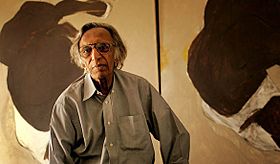Tyeb Mehta facts for kids
Quick facts for kids
Tyeb Mehta
|
|
|---|---|
 |
|
| Born | 26 July 1925 Kapadvanj, Gujarat, India
|
| Died | 2 July 2009 (aged 83) Mumbai, India
|
| Nationality | Indian |
| Education | Sir J.J. School of Art (1952) |
| Known for | Painting |
|
Notable work
|
Celebration Kali |
| Awards | Kalidas Samman (1988) Padma Bhushan (2007) |
Tyeb Mehta (born July 26, 1925 – died July 2, 2009) was a famous Indian artist. He was a painter, a sculptor, and even a filmmaker.
Tyeb Mehta was a key member of the Bombay Progressive Artists' Group. This group of artists helped shape modern Indian art. They looked at Western art styles like Modernism, Post-impressionism, and Cubism. These styles used bright colors, unique shapes, and strong brushstrokes.
Some of his most well-known paintings include Celebration and Kali. His painting Celebration sold for a very high price in 2002. This sale helped start a big interest in Indian art around the world. He also created the 'Diagonal Series' and the 'Santiniketan triptych' series. Tyeb Mehta lived and worked in Mumbai for most of his life. He also spent time in London, New York, and Santiniketan, which all influenced his art. He received many awards, including the Padma Bhushan in 2007.
Contents
Early Life and Art Training
Tyeb Mehta was born on July 26, 1925, in Kapadvanj, a town in Gujarat, India. He grew up in the Crawford Market area of Mumbai.
When he was 22, in 1947, he saw a very sad event during the Partition of India riots in Mumbai. This experience deeply affected him. It made his artwork often show strong and sometimes upsetting feelings.
Before becoming a full-time artist, he worked as a film editor. He learned how to put films together in a cinema lab. Later, in 1952, he earned his diploma from the Sir J.J. School of Art. He then joined the Bombay Progressive Artists' Group. This group included other famous Indian painters like F.N. Souza, S.H. Raza, and M. F. Husain.
Tyeb Mehta's Art Career
Tyeb Mehta moved to London in 1959 and lived there until 1964. While in London, his art was inspired by the strong, emotional style of artist Francis Bacon.
In 1968, he received a special award called a fellowship from the Asian Cultural Council. This allowed him to visit New York City. In New York, his art style changed to be more simple, known as minimalism.
He also made a short, three-minute film called Koodal. This word means 'meeting place' in Tamil. He filmed it at a slaughterhouse in Bandra. The film won an award in 1970.
From 1984 to 1985, he was an Artist-in-Residence at Santiniketan. This time also brought new changes to his artwork.
Famous Art Series
Tyeb Mehta often painted themes like bulls and rickshaw pullers. In the 1970s, he started his 'Diagonal series'. He discovered this style by accident in 1969. He was frustrated and threw a black streak across his canvas, which gave him the idea.
Later, in 1991, he created his 'Falling Figures' series. These paintings were based on his memory of the violent event he saw during the 1947 riots. He also added many figures from Indian mythology to his art. These included the goddess Kali and the demon Mahishasura.
Art Sales and Impact
Tyeb Mehta's paintings became very valuable. In 2002, his painting Celebration sold for a record price at an auction. It was the highest price ever paid for an Indian painting at an international auction at that time. This sale helped make Indian art more popular around the world.
In 2005, his painting Kali also sold for a high price. Another painting, which showed the goddess Durga and the demon Mahishasura, sold for over a million dollars. By 2008, one of his paintings sold for $2 million.
Tyeb Mehta was one of the first modern Indian artists whose work sold for over a million dollars. This showed a growing interest in Indian art globally. Because of this, Tyeb Mehta became a cultural hero in India.
Awards and Recognition
Tyeb Mehta received many important awards during his career:
- In 1968, he got a fellowship from the Asian Cultural Council.
- In the same year, he won a gold medal for his paintings in New Delhi.
- In 1974, he received the Prix Nationale in France.
- He was given the Kalidas Samman award in 1988 by the Madhya Pradesh Government.
- In 2005, he received the Dayawati Modi Foundation Award for Art, Culture, and Education.
- In 2007, he was honored with the Padma Bhushan, one of India's highest civilian awards.
- His film Koodal won the Filmfare Critics' Award in 1970.
Tyeb Mehta's art has been shown in famous museums. These include the Museum of Modern Art in Oxford, England, and the Hirshhorn Museum and Sculpture Garden in the United States. A large show of his work was planned for the National Gallery of Modern Art in New Delhi in 2009.
Images for kids


